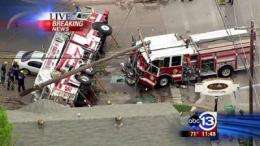Engineers test smart traffic systems to reduce first responder deaths

Thugs and fires are obvious threats for police and firefighters, but traffic accidents also pose a serious danger for first responders.
Nearly 13 percent of the firefighters and police officers who die in the line of duty are killed in vehicle-related incidents, and fire trucks are involved in ten times as many collisions as other heavy trucks.
Researchers from the University of Arizona have teamed up with the Maricopa County Department of Transportation (MCDOT) in an effort to radically lower these statistics by creating a system that will make intersections safer for emergency responders and the general public.
A prototype of this system is being installed at six intersections in Maricopa County at Anthem, Ariz., north of Phoenix, and will be tested this summer, according to Dr. Larry Head of the UA College of Engineering's Department of Systems and Industrial Engineering, and Faisal Saleem, MCDOT Intelligent Transportation Systems engineer.
The traffic control system can simultaneously communicate and give traffic signal priority to multiple emergency vehicles converging at the same time at the same intersection. This experimental vehicle communication technology can help prevent emergency responders from colliding with one another at strategic intersections.
By contrast, the systems installed at most intersections today fall short of this. The signals communicate with emergency vehicles by infrared light and the first vehicle in the area pre-empts the signal. Flashing white lights above the signals show that a pre-empt signal has been received, but that just means there's an emergency vehicle in the area. If two or more responders are approaching an intersection, they're not aware of one another or if the signal is being pre-empted for them or someone else, Head noted. This can lead to serious collisions.
In addition to smart control at intersections, the system will allow emergency vehicles at the scene to broadcast their locations so other vehicles not involved in the incident will know which lanes are closed and can select alternate routes to reach other emergencies or to find a clear corridor to hospitals. If additional emergency vehicles are heading for the incident, they will be able to find the fastest routes through traffic.
"Our tests of this system will significantly advance the technology and make intersections safer for emergency responders," Saleem said. "We also hope it will improve response times where seconds can mean the difference between life and death."
The efforts of UA engineers and Maricopa County traffic engineers are part of a national push to create smart vehicles that communicate with one another, as well as with traffic control systems. The National Highway Traffic Safety Administration -- which mandates seatbelts for all cars and trucks -- may require every vehicle sold in the United States to be equipped with this technology by 2013, which could nearly eliminate rear-end collisions, red-light running and left-turn smashups.
Head, who has been working on intelligent traffic design since 1992, says the systems are getting a lot smarter. He's excited about the upcoming tests in Maricopa County. The equipment installation and software setup will be in April and May, and tests are scheduled to run through the summer until Sept. 1.
The partnership between Maricopa County's Department of Transportation and UA's Systems and Industrial Engineering Department has been vital in bringing the intelligent traffic control system to life.
"Our universities have so much talent and can give a lot of benefit to public agencies by doing this kind of applied research," Saleem said.
Provided by University of Arizona College of Engineering


















